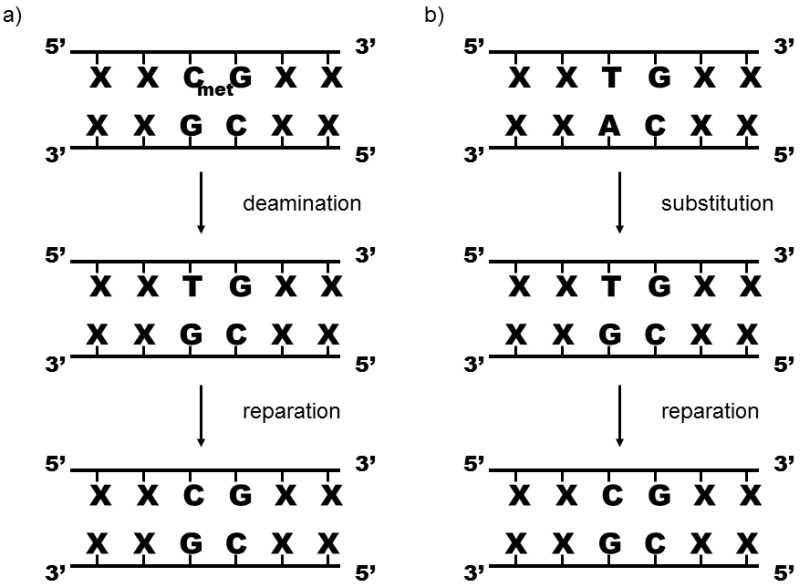VI.1.1 Mutation bias and reparation drive are two closely related and interconnected processes; however, it is useful to differentiate between them in certain contexts.
It is frequently difficult to draw a sharp boundary line between mutation bias and reparation drive. Both processes have very similar external manifestations and similar or even identical molecular processes are responsible for them both. Nonetheless, it is apparently advantageous to differentiate between these closely related processes. While only the chemical-physical properties of nucleic acids or

Fig. VI.1. Mutation bias and reparation drive. Mutation bias (a) occurs when mutation in a certain direction, e.g. substitution of cytosine by thymine, occurs more frequently than mutation in the opposite direction, i.e., in this case, substitution of thymine by cytosine. The genomes of a great many organisms contain a high percentage of cytosine in the methylated form, where thymine is formed by demethylation. As this reaction does not occur in the opposite direction, the frequency of mutation substitution of cytosine by thymine is actually greater than the frequency of substitution of thymine by cytosine. In reparation drive (b), certain types of mutations and damage are preferentially repaired in a certain manner. For example, in organisms where mutation bias acts towards replacement of cytosine by thymine, a non-pairing couple of TG bases is more frequently repaired to CG than to TA. Reparation drive thus actually compensates and neutralizes the action of mutation bias; on the other hand, in areas of the genome where mutation bias is, for some reason, not active, reparation drive can cause a gradual increase in the content of GC-pairs (see the hypothesis of the formation of isochores in the genomes of warm-blooded organisms, Section VI.1.1.1).
molecules that interact with the nucleic acids are responsible for mutation bias, reparation drive is a process whose manifestations are, at the very least, partly tuned, i.e. from a functional standpoint more or less optimized through natural selection. As a consequence of this tuning, mutation bias and reparation drive frequently act in opposite directions and neutralize one another in their effects. For example, methylated dinucleotides CG frequently mutate to TG, as deamination of methylated cytosine yields thymine. Consequently, the cell nucleus contains molecular repair systems that preferentially replace nucleotide T by nucleotide C at sites where the G-T pair is present instead of the G-C pair in opposing positions on the DNA (Brown & Jiricny 1988). Where the mutation actually occurred through deamination of methylated cytosine, the repair system renews the original DNA sequence (Fig. VI.1a). Where the mutation occurred through some other mechanism and, on the other hand, the incorrect nucleotide is G in the opposing strand, the repair mechanism conserves the mutation (Fig. VI.1b). In DNA segments where deamination occurs very frequently, i.e. mutation bias leads to replacement of nucleotide C by nucleotide T, in segments where these mutations do not occur, in contrast, nucleotide T is replaced by nucleotide C through reparation drive.
